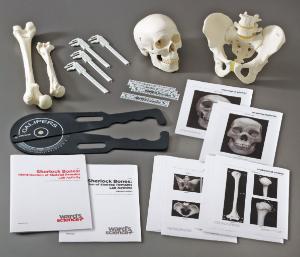Boo-tiful Bone Facts and Science Activities for Halloween Fun
Elementary & Middle School
As the air chills and the leaves change, we’ll be creeping it real this Halloween. We’ll start by helping to clear up some of the unknowns about bones. We’ve also scared up some fun activities below that can support your lesson plans on skeletal systems.
Here are some interesting facts about skeletal systems your students can gnaw on:
Types of skeletal systems
The connection between an animal’s skeleton (anatomy) and its behavior is remarkable. The system's primary function is to help give animals support, protection, and movement. There are three types of skeleton designs:
1. Hydrostatic skeletons - a fluid-filled compartment held under hydrostatic pressure. Animals with these systems bend and move around when the muscles produce pressure on the fluid.
Many simple invertebrate organisms rely on hydrostatic skeletons. Earthworms, octopuses, jellyfish, sea anemones, and starfish are common examples.
The good news is invertebrates can squeeze in and out of tight spaces and heal more easily than animals with rigid bones. The bad news is a hydrostatic structure limits the animal's ability to have limbs that can latch on and hold things and restricts them to environments that can replenish their fluid needs like blood or water.
2. Exoskeletons - a hard external skeleton that protects the outer surface of an organism and enables movement through muscles attached on the inside. Animals that use this protective armor include crustaceans (e.g., crabs and lobsters), insects (e.g., beetles, cicadas, caterpillars), and arachnids (including the Curly Haired Tarantula). Most exoskeletons contain the biopolymer chitin, calcium, and carbonate to give this structure the remarkable strength it provides. But, no worries, the tough shell of those tasty crustaceans is no match for our simple but effective crab crackers!
3. Endoskeletons - an internal skeleton composed of hard, mineralized tissue that enables movement by attaching to muscles. Mammals, reptiles, birds, fish, and amphibians are vertebrates with endoskeletons. The endoskeleton is made up of two tissue types (bone and cartilage). It comprises the axial skeleton (cranium, visceral skeleton, notochord, vertebrae, and ribs) and the appendicular skeleton (paired fin or limbs and the pelvis). Muscles attach to the bony surfaces by tendons enabling the animal to move. The endoskeleton enables many vertebrate animals to grow large; “them bones them bones” provide enough support to hold a lot of weight. On the other hand, bones take a long time to heal when broken and weaken as animals age.
Treat your class to these spooktacular hands-on activities this fall. Students can investigate the structure, development, growth, and function of skeletal systems.
Terrifyingly fun Tarantula Activity
Curly hair tarantula (Brachypelma albopilosum) are nocturnal hunters that lie in wait for prey in their burrows. They are docile and calm when handled, making them a fascinating classroom pet. They are molting creatures, which means they will shed their exoskeleton as they mature and grow larger.
They live for years on a diet of crickets, and because they can bite when provoked, we recommend housing them alone and handling them with care. They'll easily become accustomed to being handled and will remain friendly unless they feel threatened.
Just before molting, tarantulas may exhibit strange behaviors such as failure to eat, very little movement, and often spin silk to protect themselves from predators.
Watch this video to get better acquainted with this eight-legged friend and learn how to handle properly and care for them in your classroom.
Download the Care and Handling Guide
Bone up on structure and anatomy
Get the Mammal Bone Comparison set so students can compare mammal metatarsal bones (horse, cow, pig, and chicken). The longitudinal section makes it possible to clearly explain the bones' stability and allow conclusions about the animal's locomotion.
The set demonstrates typical bone structure and anatomy and includes a real
- Femur
- Humerus
- Metacarpal
- Metatarsal
Skeleton Lab Bone-anza
 The Sherlock Bones: Identification of Skeletal Remains Kit provides students with experience with epiphyseal union Vernier calipers. Students are given a few bones and then take the role of a forensic anthropologist to determine as much information as possible to help identify the individual. Students will become familiar with some of the techniques performed by a forensic anthropologist and some of the challenges one may encounter along the way.
The Sherlock Bones: Identification of Skeletal Remains Kit provides students with experience with epiphyseal union Vernier calipers. Students are given a few bones and then take the role of a forensic anthropologist to determine as much information as possible to help identify the individual. Students will become familiar with some of the techniques performed by a forensic anthropologist and some of the challenges one may encounter along the way.
Shop for Kit Now
Measuring Tools and Guides for Kit
The team at Ward’s Science hopes you and your students have an enjoyable, safe, and science-filled Halloween!
Our expert biologists and lab technicians are here to help with questions or one-on-one support with your live materials—Email sciencehelp@vwr.com for personalized support, custom orders, and more.
